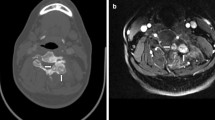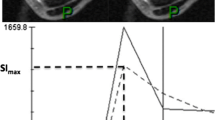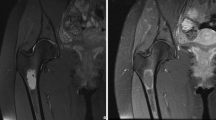Abstract
Background
While typical patterns of osteoid osteoma have been described on CT, MRI findings can overlap among different diseases, and atypical patterns exist. In this study, we assessed the presence of a novel dark rim sign and its utility in the MRI diagnosis of osteoid osteoma.
Objective
The purpose of this retrospective study was to assess the utility of the dark rim sign seen on MRI in children with osteoid osteoma.
Materials and methods
MRI studies from 36 pediatric patients with osteoid osteoma and a control group of patients with either osteomyelitis or stress fracture were analyzed and then compared for the presence of the dark rim sign. Patients from the osteoid osteoma group were further divided based on nidus location and evaluated for the presence of the dark rim sign.
Results
The relationship between the dark rim sign and osteoid osteoma was statistically significant (P<0.001). A dark rim sign was identified in 25 of the 36 patients with osteoid osteoma. None of the control patients had a dark rim sign. The dark rim sign had 69.4% sensitivity, 100% specificity, 100% positive predictive value and 72.5% negative predictive value for detecting osteoid osteoma. The relationship between dark rim sign and nidus location was statistically significant (P<0.001) such that endosteal and medullary osteoid osteomas were more likely to have a dark rim sign than intracortical osteoid osteomas.
Conclusion
When the nidus of an osteoid osteoma is in an endosteal or medullary location, the dark rim sign may aid in the diagnosis.




Similar content being viewed by others

References
Kransdorf MJ, Stull MA, Gilkey FW, Moser RP Jr (1991) Osteoid osteoma. Radiographics 11:671–696
Iyer RS, Chapman T, Chew FS (2012) Pediatric bone imaging: diagnostic imaging of osteoid osteoma. AJR Am J Roentgenol 198:1039–1052
Niu X, Xu H, Inwards CY et al (2015) Primary bone tumors: epidemiologic comparison of 9,200 patients treated at Beijing Ji Shui Tan Hospital, Beijing, China, with 10,165 patients at Mayo Clinic, Rochester, Minnesota. Arch Pathol Lab Med 139:1149–1155
Dahlin D (1970) Bone tumors, 2nd edn. Thomas, Springfield
Czerniak B (2016) Dorfman and Czerniak's bone tumors, 4th edn. Elsevier, Philadelphia
Goldman AB, Schneider R, Pavlov H (1993) Osteoid osteomas of the femoral neck: report of four cases evaluated with isotopic bone scanning, CT, and MR imaging. Radiology 186:227–232
Golding JS (1954) The natural history of osteoid osteoma; with a report of twenty cases. J Bone Joint Surg Br 36-B:218–229
Carra BJ, Chen DC, Bui-Mansfield LT (2016) The half-moon sign of the femoral neck is nonspecific for the diagnosis of osteoid osteoma. AJR Am J Roentgenol 206:W54
Assoun J, Richardi G, Railhac JJ et al (1994) Osteoid osteoma: MR imaging versus CT. Radiology 191:217–223
Woods ER, Martel W, Mandell SH, Crabbe JP (1993) Reactive soft-tissue mass associated with osteoid osteoma: correlation of MR imaging features with pathologic findings. Radiology 186:221–225
Davies M, Cassar-Pullicino VN, Davies AM et al (2002) The diagnostic accuracy of MR imaging in osteoid osteoma. Skelet Radiol 31:559–569
Hosalkar HS, Garg S, Moroz L et al (2005) The diagnostic accuracy of MRI versus CT imaging for osteoid osteoma in children. Clin Orthop Relat Res 433:171–177
Lefton DR, Torrisi JM, Haller JO (2001) Vertebral osteoid osteoma masquerading as a malignant bone or soft-tissue tumor on MRI. Pediatr Radiol 31:72–75
Liu PT, Chivers FS, Roberts CC et al (2003) Imaging of osteoid osteoma with dynamic gadolinium-enhanced MR imaging. Radiology 227:691–700
Spouge AR, Thain LM (2000) Osteoid osteoma: MR imaging revisited. Clin Imaging 24:19–27
Klontzas ME, Zibis AH, Karantanas AH (2015) Osteoid osteoma of the femoral neck: use of the half-moon sign in MRI diagnosis. AJR Am J Roentgenol 205:353–357
Costa FM, Canella C, Vieira FG et al (2018) The usefulness of chemical-shift magnetic resonance imaging for the evaluation of osteoid osteoma. Radiol Bras 51:156–161
Brenner DJ, Hall EJ (2007) Computed tomography — an increasing source of radiation exposure. N Engl J Med 357:2277–2284
Ogbole GI (2010) Radiation dose in paediatric computed tomography: risks and benefits. Ann Ib Postgrad Med 8:118–126
Pearce MS, Salotti JA, Little MP et al (2012) Radiation exposure from CT scans in childhood and subsequent risk of leukaemia and brain tumours: a retrospective cohort study. Lancet 380:499–505
Graham GN, Browne H (2001) Primary bony tumors of the pediatric spine. Yale J Biol Med 74:1–8
Kneisl JS, Simon MA (1992) Medical management compared with operative treatment for osteoid-osteoma. J Bone Joint Surg Am 74:179–185
Neyisci C, Erdem Y (2019) Safe and effective treatment choice for osteoid osteoma: computed tomography-guided percutaneous radiofrequency ablation. Cureus 11:e5526
Yu X, Wang B, Yang S et al (2019) Percutaneous radiofrequency ablation versus open surgical resection for spinal osteoid osteoma. Spine J 19:509–515
Koch G, Cazzato RL, Gilkison A et al (2018) Percutaneous treatments of benign bone tumors. Semin Intervent Radiol 35:324–332
Pottecher P, Sibileau E, Aho S et al (2017) Dynamic contrast-enhanced MR imaging in osteoid osteoma: relationships with clinical and CT characteristics. Skelet Radiol 46:935–948
Laurence N, Epelman M, Markowitz RI et al (2012) Osteoid osteomas: a pain in the night diagnosis. Pediatr Radiol 42:1490–1501
Zampa V, Bargellini I, Ortori S et al (2009) Osteoid osteoma in atypical locations: the added value of dynamic gadolinium-enhanced MR imaging. Eur J Radiol 71:527–535
Epelman M, Jaramillo D, Hosalkar HS et al (2008) Usefulness of the "hypointense halo sign" in the MRI diagnosis of osteoid osteoma. Pediatr Radiol 38:S296
Kayser F, Resnick D, Haghighi P et al (1998) Evidence of the subperiosteal origin of osteoid osteomas in tubular bones: analysis by CT and MR imaging. AJR Am J Roentgenol 170:609–614
IBM Corporation (2016) SPSS Statistics for Windows, Version 24.0. IBM SPSS software website. https://www.ibm.com/analytics/spss-statistics-software. Accessed 6 Mar 2020
Cohen MD, Harrington TM, Ginsburg WW (1983) Osteoid osteoma: 95 cases and a review of the literature. Semin Arthritis Rheum 12:265–281
Mirra JM, Gold RH (1989) Osseous tumors of intramedullary origin. In: Bone tumors: clinical, radiologic, and pathologic correlations. Lea & Febiger, Philadelphia, pp 143–438
Orlowski JP, Mercer RD (1977) Osteoid osteoma in children and young adults. Pediatrics 59:526–532
Klein MH, Shankman S (1992) Osteoid osteoma: radiologic and pathologic correlation. Skelet Radiol 21:23–31
Author information
Authors and Affiliations
Corresponding author
Ethics declarations
Conflicts of interest
Dr. Meyers is an author/editor for Elsevier/Amirsys receiving royalties.
Additional information
Publisher’s note
Springer Nature remains neutral with regard to jurisdictional claims in published maps and institutional affiliations.
Appendix
Appendix
Rights and permissions
About this article
Cite this article
French, J., Epelman, M., Jaramillo, D. et al. Magnetic resonance imaging evaluation of osteoid osteoma: utility of the dark rim sign. Pediatr Radiol 50, 1742–1750 (2020). https://doi.org/10.1007/s00247-020-04780-4
Received:
Revised:
Accepted:
Published:
Issue Date:
DOI: https://doi.org/10.1007/s00247-020-04780-4



